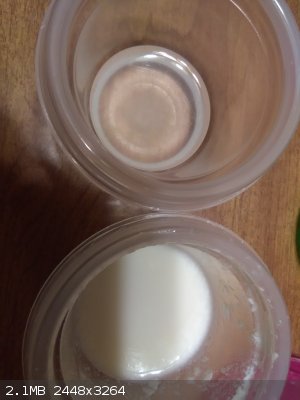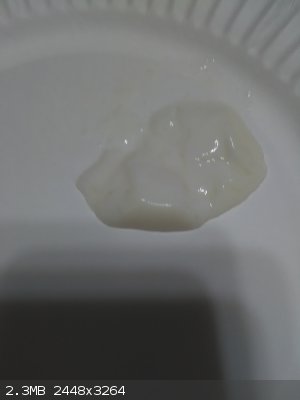symboom
International Hazard
    
Posts: 1143
Registered: 11-11-2010
Location: Wrongplanet
Member Is Offline
Mood: Doing science while it is still legal since 2010
|
|
Oxone and methanol reaction produces formaldehyde?
So as many know I have been working with oxone
When I ran into its reaction with alcohols
It slowly reacts now I dont know what I made but it smells I dont know how describe it.
The clear liquid has yellow like liquid floating in it
It is oxone and isopropyl alcohol and the other one is methyl alcohol with oxone formed an insoluble mix the oxone did not desolve well so I added
water but the alcohols are clearly reacting slowly the methanol mix is white solid slush and smells. Both on the bottom there is a yellow color.

[Edited on 10-1-2017 by symboom]

[Edited on 10-1-2017 by symboom]
Whats going on here what is the alcohols being oxidized to?
[Edited on 10-1-2017 by symboom]
|
|
|
symboom
International Hazard
    
Posts: 1143
Registered: 11-11-2010
Location: Wrongplanet
Member Is Offline
Mood: Doing science while it is still legal since 2010
|
|
Enviroment for bacteria and mold
I do not like starting new posts if its a continuation
Not sure if this is a new find or just aging
So like before I had methanol and oxone mix and I had this odd smell for all those biologist it formed different molds and bacteria because I am not
familiar and not equipt to work with it.
it was all promptly destroyed there after
The mixture was stored in a small sealed container
Once opened was greeted with mold and bacteria lots of different kinds.
Maybe a good enviroment for bacteria some of them thrive in it very well.
The main question what odd smell i was being produced before
Did it help in creating this environment
[Edited on 28-1-2017 by symboom]
[Edited on 28-1-2017 by symboom]
|
|
|
PHILOU Zrealone
International Hazard
    
Posts: 2893
Registered: 20-5-2002
Location: Brussel
Member Is Offline
Mood: Bis-diazo-dinitro-hydroquinonic
|
|
Be cautious that some alcohol may form keton or aldehyds that when reacted with oxone forms dangerously explosive peroxides....
PH Z (PHILOU Zrealone)
"Physic is all what never works; Chemistry is all what stinks and explodes!"-"Life that deadly disease, sexually transmitted."(W.Allen)
|
|
|
symboom
International Hazard
    
Posts: 1143
Registered: 11-11-2010
Location: Wrongplanet
Member Is Offline
Mood: Doing science while it is still legal since 2010
|
|
I think I figured out the smell and the goo its paraformaldehyde
So methanol oxidizes to aldehyde in oxone solution?
|
|
|
AJKOER
Radically Dubious
    
Posts: 3026
Registered: 7-5-2011
Member Is Offline
Mood: No Mood
|
|
Quote: Originally posted by symboom  | I think I figured out the smell and the goo its paraformaldehyde
So methanol oxidizes to aldehyde in oxone solution? |
In my opinion the unspecified agent is an activitating transition metal impurity (likely Fe(ll) here) working with the 2KHSO5·KHSO4·K2SO4. For
associated properties, see http://www.cruso.es/FICHAS/33Oxone.htm.
Of special concern working with KHSO5 is the presence of transition metal impurities (like cobalt, for example, but no reference citing this is indeed
a contaminant here), as one can be deceived as to what is actually occurring! In fact, a trace of cobalt ions in the presence of HSO5- can produce the
powerful sulfate radical anion (see "COBALT/PEROXYMONOSULFATE AND RELATED OXIDIZING REAGENTS FOR WATER TREATMENT" a thesis by Georgios P. Anipsitakis,
https://etd.ohiolink.edu/rws_etd/document/get/ucin1130533674... ). To quote from the dissertation:
" It was found that when Co(II), Ru(III) and Fe(II) interact with KHSO5, freely diffusible sulfate radicals are the primary species formed."
Note, the sulfate radical, .SO4, is just a little less potent than the hydroxyl radical, .OH, which will breakdown compounds with a sequence of
abstraction reactions. Also, in the presence of O2 (or a contributing agent like KHSO5), an oxygen addition reaction could occur with the breakdown
products.
One could also describe the sole action of Fe(ll) on KHSO5 (which acts here as a H2O2 substitute) as a so called fenton-type reaction producing
powerful sulfate (as opposed to hydroxyl) radicals.
[Edited on 11-6-2017 by AJKOER]
[Edited on 11-6-2017 by AJKOER]
|
|
|
Melgar
Anti-Spam Agent
    
Posts: 2004
Registered: 23-2-2010
Location: Connecticut
Member Is Offline
Mood: Estrified
|
|
Are you sure there's mold or bacteria in there? I mean, oxone is used as pool shock to kill those things specifically. If it was white slimy stuff
that smelled like formaldehyde, it was probably just paraformaldehyde, which tends to form in formaldehyde solution over time. If you want to know
what formaldehyde smells like, drop a piece of a broken Keck clamp into sulfuric acid.
The first step in the process of learning something is admitting that you don't know it already.
I'm givin' the spam shields max power at full warp, but they just dinna have the power! We're gonna have to evacuate to new forum software!
|
|
|
symboom
International Hazard
    
Posts: 1143
Registered: 11-11-2010
Location: Wrongplanet
Member Is Offline
Mood: Doing science while it is still legal since 2010
|
|
how can I test for it what is the best method ive been wanted to figure out a way to make it. I have been wanting formaldehyde so this is a
convenient way. Dont want to buy calcium formate. Thank you everyone for imput.
More and more oxone is becoming one of my favorite chemicals the more uses out of a pound of it the stuff the better
|
|
|
JJay
International Hazard
    
Posts: 3440
Registered: 15-10-2015
Member Is Offline
|
|
Formaldehyde has a distinctive smell that you can probably recognize from biology classes. I think it can be detected with Tollens' reagent.
|
|
|
Melgar
Anti-Spam Agent
    
Posts: 2004
Registered: 23-2-2010
Location: Connecticut
Member Is Offline
Mood: Estrified
|
|
Formaldehyde smells... not so good, and as though you're breathing something that is probably going to damage you in some way if you continue to
inhale it. Definitely unpleasant, but not very much like any of the unpleasant smells you're probably already familiar with. Formaldehyde
polymerizes reversibly and spontaneously, especially in the presence of acids. If you just want to smell formaldehyde, dilute sulfuric acid on
particle board will probably get you a whiff of it, since particle board is held together with urea-formaldehyde resin that's prone to hydrolysis.
A better source would be polyoxymethylene plastic, often called acetal, polyacetal, POM, and Delrin. It's used to make glassware clamps, some guitar
picks, and those plastic rivets that hold a car's interior together.
Those contain dyes that make it impure though, so 1,3,5 trioxane is probably the best non-odorous form of formaldehyde. It used to be in military
portable fuel tablets, but the small amount of formaldehyde released when it burned sometimes got in food and made it gross, so the military switched
to an ethylene glycol portable fuel, and the old trioxane bars are all over eBay for about a buck each. They have this purple stuff in them, that
should probably come out. If you put all the trioxane into a large sealed container where the top is a lower temperature than the bottom, it will
sublime and form large, oddly-flexible crystals. I put mine in a quart-sized Chinese takeout soup container, filled the depression in the top with
water, and set it on my radiator in the morning, and had a layer of trioxane crystallized on the inside of the lid by the time I'd come home.
The first step in the process of learning something is admitting that you don't know it already.
I'm givin' the spam shields max power at full warp, but they just dinna have the power! We're gonna have to evacuate to new forum software!
|
|
|
AJKOER
Radically Dubious
    
Posts: 3026
Registered: 7-5-2011
Member Is Offline
Mood: No Mood
|
|
Quote: Originally posted by AJKOER  | Quote: Originally posted by symboom  | I think I figured out the smell and the goo its paraformaldehyde
So methanol oxidizes to aldehyde in oxone solution? |
In my opinion the unspecified agent is an activitating transition metal impurity (likely Fe(ll) here) working with the 2KHSO5·KHSO4·K2SO4. For
associated properties, see http://www.cruso.es/FICHAS/33Oxone.htm.
Of special concern working with KHSO5 is the presence of transition metal impurities (like cobalt, for example, but no reference citing this is indeed
a contaminant here), as one can be deceived as to what is actually occurring! In fact, a trace of cobalt ions in the presence of HSO5- can produce the
powerful sulfate radical anion (see "COBALT/PEROXYMONOSULFATE AND RELATED OXIDIZING REAGENTS FOR WATER TREATMENT" a thesis by Georgios P. Anipsitakis,
https://etd.ohiolink.edu/rws_etd/document/get/ucin1130533674... ). To quote from the dissertation:
" It was found that when Co(II), Ru(III) and Fe(II) interact with KHSO5, freely diffusible sulfate radicals are the primary species formed."
Note, the sulfate radical, .SO4, is just a little less potent than the hydroxyl radical, .OH, which will breakdown compounds with a sequence of
abstraction reactions. Also, in the presence of O2 (or a contributing agent like KHSO5), an oxygen addition reaction could occur with the breakdown
products.
One could also describe the sole action of Fe(ll) on KHSO5 (which acts here as a H2O2 substitute) as a so called fenton-type reaction producing
powerful sulfate (as opposed to hydroxyl) radicals.
[Edited on 11-6-2017 by AJKOER] |
Researched and documented a pathway, for those interested:
Co(ll)/Fe(ll) + HSO5- → Co(lll)/Fe(lll) + SO4-• + OH- (Eq. 2.1 for Cobalt)
[Note, if HSO5- is in excess: Co(lll)/Fe(lll)+ HSO5- → Co(ll)/Fe(ll) + SO5-• + H+ (Eq.1.11 & 3.8 for Fe]
SO4•- + CH3OH → HSO4- + •CH2OH (Eq. 5.22)
Source for numbered equations: Georgios Anipsitakis ,Ph.D. thesis, "Cobalt/Peroxymonosulfate and Related Oxidizing Reagents for Water Treatment", June
2005, Link: https://www.google.com/url?sa=t&source=web&rct=j&... .
•CH2OH + Fe(lll)/Co(lll) = HCHO + H+ + Fe(ll)/Co(ll)
Source: Equation (4) at http://www.nature.com/articles/ncomms12333, "Dehydrogenation of anhydrous methanol at room temperature by o-aminophenol-based photocatalysts", by
Masanori Wakizaka, et al, in Nature Communications 7, Article number: 12333, (2016), doi:10.1038/ncomms12333., where the author states:
"The ·CH2OH radical is a good reducing agent and able to react with electron acceptors (EA) such as Fe(III) or Co(III), which affords HCHO as the
oxidized species (equation 4)."
Also, of possible interest, associated reaction for ethanol:
SO4•- + CH3CH2OH → HSO4- + CH3•CHOH (Eq. 5.23)
[Edit] Speculation on reaction between methanol and SO5•- to be:
SO5•- + CH3OH → HSO5- + •CH2OH (reaction not verified)
which would be very interesting as it implies a cycling of HSO5- via the first two reaction above.
------------------------------------
Found an important point on various routes to the sulfate radical anion other than transition metals, to quote from Ruobai Li, et al, paper, "A
sulfate radical based ferrous–peroxydisulfate oxidative system for indomethacin degradation in aqueous solutions", RSC Adv., 2017, 7, 22802-22809,
DOI: 10.1039/C7RA03364H :
"The sulfate radical SO4˙− is very promising for the degradation of organic pollutants due to its high oxidation potential (E0 = 2.6 V),
particularly when applied to aromatic pollutants. This radical may be generated via the activation of KHSO5 and K2S2O8 in conjunction with radiation,
photolysis, microwave and heat.9–14 Moreover, transition metal ions are also able to activate K2S2O8 to form SO4˙−. Sulfate radicals have a
longer half-life than hydroxyl radicals, primarily due to their preference for electron transfer reactions. Hydroxyl radicals may also react via
hydrogen-atom abstraction and addition, along with electron transfer, which plays a less important role.15–17"
Link: http://pubs.rsc.org/en/content/articlehtml/2017/RA/C7RA03364...
[Edited on 12-6-2017 by AJKOER]
[Edited on 12-6-2017 by AJKOER]
|
|
|
|